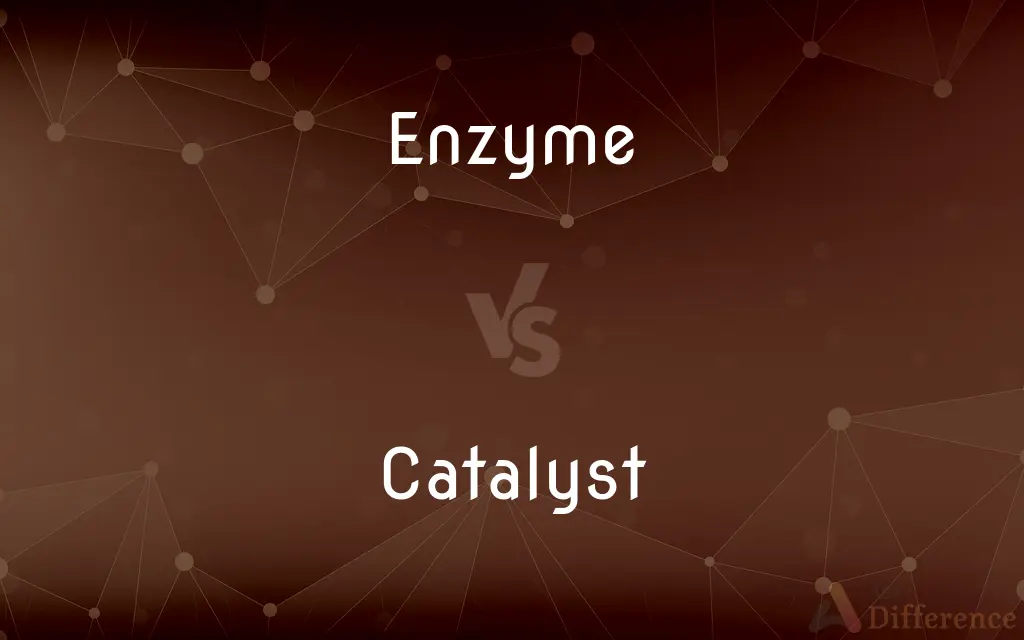Enzyme vs. Catalyst — What's the Difference?
By Maham Liaqat & Urooj Arif — Updated on March 13, 2024
Enzymes are biological catalysts made of proteins that speed up chemical reactions in living organisms, whereas catalysts are a broader group of substances, including enzymes, that accelerate reaction rates without being consumed in the process.

Difference Between Enzyme and Catalyst
Table of Contents
ADVERTISEMENT
Key Differences
Enzymes are a specific type of catalyst that operate in the complex and controlled environment of living cells, facilitating a wide range of biochemical reactions necessary for life. These reactions include metabolism, DNA replication, and the synthesis and breakdown of molecules. Enzymes are highly specific, typically catalyzing only one type of chemical reaction or working on a particular type of substrate due to their unique three-dimensional structures. On the other hand, catalysts are a more general category and can be chemical substances, metals, or even metal oxides that increase the rate of chemical reactions in various settings, from industrial processes to environmental systems.
While enzymes function optimally within narrow ranges of temperature and pH, and can be denatured or inactivated by extreme conditions, non-biological catalysts are often designed to operate under much harsher conditions, such as high temperatures and pressures in industrial chemical reactors. This difference highlights the specialized nature of enzymes as compared to the broader resilience and application of general catalysts.
The specificity of enzymes is largely due to their complex protein structures, which provide unique active sites perfectly shaped to bind to their specific substrates. This "lock and key" model ensures that enzymes catalyze reactions with high efficiency and fidelity. In contrast, non-biological catalysts might not exhibit such a high degree of specificity, allowing them to catalyze a wider range of reactions but often with less precision.
Both enzymes and non-biological catalysts play critical roles in their respective domains. Enzymes are indispensable for life processes, while catalysts are crucial in various industries, including the manufacture of plastics, pharmaceuticals, and fuels, as well as in pollution control technologies. Despite their differences, the underlying principle is the same: both types of catalysts lower the activation energy required for reactions, thereby increasing the reaction rate.
Comparison Chart
Nature
Biological proteins
Broad group including chemicals, metals, and enzymes
ADVERTISEMENT
Function
Speed up biochemical reactions in living organisms
Accelerate chemical reactions without being consumed
Specificity
High specificity to substrates and reactions
Varies, from specific to broad
Operating Conditions
Optimal in narrow temperature and pH ranges
Can function under a wide range of conditions
Structural Complexity
Complex three-dimensional structures
Varies, from simple to complex
Applications
Vital for life processes like metabolism
Used in industries, environmental systems, etc.
Reaction Precision
Highly precise due to specific active sites
Less precise, can catalyze multiple reactions
Susceptibility to Conditions
Can be denatured by extreme conditions
Often more resilient to harsh conditions
Compare with Definitions
Enzyme
Biological proteins that catalyze biochemical reactions.
The enzyme amylase breaks down starch into sugars in the human digestive system.
Catalyst
Substances that increase the rate of chemical reactions.
Platinum is used as a catalyst in catalytic converters to reduce car emissions.
Enzyme
Highly specific to their substrates and reactions.
The enzyme lactase is specific to the lactose substrate.
Catalyst
Can function under a wide range of conditions.
Industrial catalysts can operate at high temperatures and pressures.
Enzyme
Characterized by complex protein structures.
The enzyme hemoglobin's structure allows it to efficiently bind and transport oxygen.
Catalyst
Can vary from specific to broad.
Hydrogen peroxide decomposition can be catalyzed by various catalysts including manganese dioxide.
Enzyme
Function within narrow temperature and pH ranges.
Human enzymes typically operate best at body temperature.
Catalyst
Varies widely, from simple ions to complex structures.
Zeolites are complex structures used as catalysts in the petroleum industry.
Enzyme
Indispensable for metabolic processes and other life functions.
DNA polymerase enzymes are crucial for DNA replication.
Catalyst
Extensively used in chemical manufacturing, environmental management, etc.
Catalysts are used in synthesizing ammonia in the Haber process.
Enzyme
Enzymes () are proteins that act as biological catalysts (biocatalysts). Catalysts accelerate chemical reactions.
Catalyst
(Chemistry) A substance, usually used in small amounts relative to the reactants, that modifies and increases the rate of a reaction without being consumed in the process.
Enzyme
Any of numerous compounds that are produced by living organisms and function as biochemical catalysts. Some enzymes are simple proteins, and others consist of a protein linked to one or more nonprotein groups.
Catalyst
A substance that increases the rate of a chemical reaction without itself undergoing any permanent chemical change
Chlorine acts as a catalyst promoting the breakdown of ozone
Enzyme
(biochemistry) A globular protein that catalyses a biological chemical reaction.
Catalyst
One that precipitates a process or event, especially without being involved in or changed by the consequences
"A free press ... has remained ... a vital catalyst to an informed and responsible electorate" (Robert O'Neal).
Enzyme
(Christianity) leavened bread, as opposed to azyme
Catalyst
(chemistry) A substance that increases the rate of a chemical reaction without being consumed in the process.
Enzyme
A protein produced by a living organism, capable of catalyzing a chemical reaction. Almost all processes in living organisms require some form of enzyme to cause the reactions to occur at a rate sufficient to support life. There are a very wide variety of enzymes, each specifically catalyzing a different chemical reaction, the sum of which cause the bulk of the physiological changes observed as life processes. Enzymes, like most proteins, are synthesized by the protein-synthetic mechanism of the living cell, at special sites on ribosomes, using the genetic information in messenger RNA transcribed from the genetic instructions stored as nuleotide sequences in the DNA (or in some viruses, the RNA) of the genome. Some examples of enzymes are: pepsin, diastase, rennet, DNA polymerase, invertase, glucose oxidase, protease, and ribonuclease. There are many other types of enzyme.
Catalyst
Something that encourages progress or change.
Economic development and integration are working as a catalyst for peace.
Enzyme
Any of several complex proteins that are produced by cells and act as catalysts in specific biochemical reactions
Catalyst
(literature) An inciting incident that sets the successive conflict into motion.
Catalyst
(automotive) A catalytic converter.
Catalyst
(fantasy) An object that facilitates the casting of a spell (such as a magic wand).
Catalyst
A substance that initiates or accelerates a chemical reaction without itself being affected; as, thousands of enzymes serve in concert as calaysts to produce the sequence of reactions we call "life"; the industrial production of cheap ammonia depended on finding a good catalyst.
Catalyst
Something that serves as a precipitating occasion for an event; as, the invasion acted as a catalyst to unite the country.
Catalyst
Something or someone that causes events to happen with itself being changed.
Catalyst
(chemistry) a substance that initiates or accelerates a chemical reaction without itself being affected
Catalyst
Something that causes an important event to happen;
The invasion acted as a catalyst to unite the country
Common Curiosities
What makes a catalyst different from a reactant?
Catalysts facilitate reactions without being consumed or altered, while reactants undergo a chemical change during the reaction.
Can enzymes function outside of biological systems?
While enzymes are optimized for biological systems, they can be used in industrial processes under controlled conditions.
What role do catalysts play in environmental protection?
Catalysts are used in pollution control technologies, such as catalytic converters, to reduce harmful emissions.
Are all enzymes catalysts?
Yes, all enzymes are catalysts, but not all catalysts are enzymes.
How do enzymes achieve such high specificity?
Enzymes achieve high specificity through their unique three-dimensional structures, which create specific active sites for their substrates.
Can the activity of enzymes be regulated?
Yes, enzyme activity can be regulated by various means, including the presence of inhibitors or activators and changes in environmental conditions.
Can the loss of enzyme activity be reversed?
In some cases, the loss of activity due to denaturation can be reversible, but it often depends on the extent and nature of the denaturation.
Why are metal catalysts widely used in industry?
Metal catalysts are favored for their efficiency, durability, and ability to catalyze a wide range of reactions.
How are catalysts chosen for industrial processes?
Catalysts are selected based on their efficiency, cost, specificity, and resilience to the operating conditions of the process.
How do temperature and pH affect enzyme activity?
Temperature and pH can significantly affect enzyme structure and function, with each enzyme having an optimal range for activity.
Share Your Discovery

Previous Comparison
Hair vs. Trichophilia
Next Comparison
Weight vs. DensityAuthor Spotlight
Written by
Maham LiaqatCo-written by
Urooj ArifUrooj is a skilled content writer at Ask Difference, known for her exceptional ability to simplify complex topics into engaging and informative content. With a passion for research and a flair for clear, concise writing, she consistently delivers articles that resonate with our diverse audience.















































